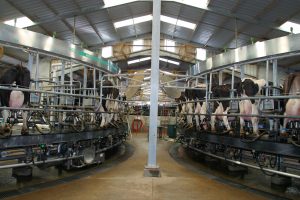By Heide Kennedy, Arizona Farm Bureau Communications Intern
Whenever you get a jug of milk from the store, you probably notice that it says “Pasteurized” on the front of it. In fact, if you look at any of the jugs of milk on the shelves, you’ll see that they all say that they have been pasteurized unless they’re being sold as raw milk. So, what exactly does it mean when milk says that it’s been pasteurized? 
Pasteurization is a process that milk undergoes to remove harmful bacteria that might be present in the milk. The process was developed about 150 years ago by Louis Pasteur (Hence the name!). He was trying to find methods for keeping harmful bacteria at bay. New Jersey was the first state to have a milk plant that had a pasteurizer, but now all milk sold in the United States is required to be pasteurized unless it’s sold as raw milk.
So, how is milk pasteurized? The pasteurization process begins when chilled milk is heated as it’s passed between stainless steel plates to about 161 degrees Fahrenheit. It is then held at this temperature for about 15 seconds before rapidly being cooled back to its usual temperature.
It’s crazy to think that just changing the temperature of the milk for that short period is enough to remove the harmful bacteria from the milk and that it does so without significantly changing the nutritional content of the milk. The only small change in the milk is that the tiny amount of vitamin C (which is less than 10% of the recommended daily allowance) doesn’t survive the pasteurization process.
The pasteurization process is honestly pretty amazing! It allows us to have both safe and nutritious milk to enjoy! If you want to read more about milk, and Arizona dairy in particular, check out the Fill Your Plate blog for some of our past articles. Also, June is National Dairy Month, so more dairy articles will be coming out this entire month!

